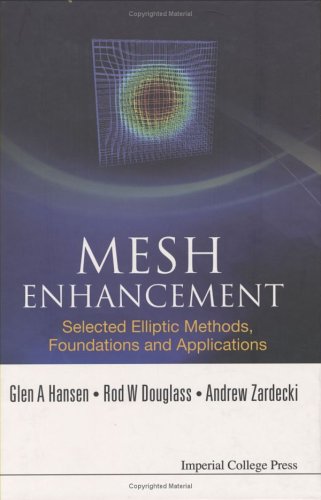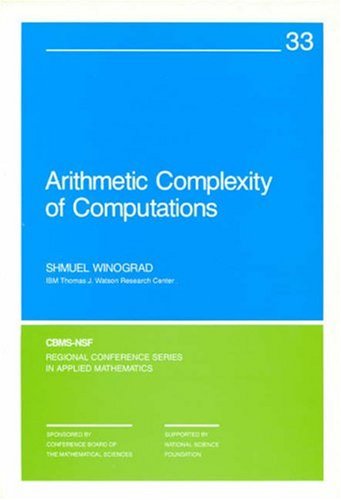Glen A. Hansen, Rod W. Douglass, Andrew Zardecki1860944876, 9781860944871, 9781860946813
Table of contents :
Front cover……Page 1
Title page……Page 3
Date-line……Page 4
Preface……Page 5
Contents……Page 9
1. Basic Concepts……Page 15
1.1 The Physics Simulation Process……Page 17
1.2 Mesh Enhancement using Elliptic Methods……Page 23
1.3.1 Mesh Topology……Page 25
1.3.2 Structured Meshes……Page 26
1.3.3 Unstructured Meshes……Page 29
1.3.4 Basic Grid Generation Algorithms……Page 30
1.3.4.1 Transfinite Interpolation Method (TFI)……Page 31
1.3.4.2 Solution-Based Methods……Page 32
1.3.4.4 Advancing Front Method……Page 33
1.3.4.5 Delaunay Triangulation Method……Page 34
1.3.4.6 Quadtree-Octree Methods……Page 35
1.3.5 Mesh Quality Issues……Page 37
2. Computational Geometry and Geometric Data Structures……Page 39
2.1.1 Curves……Page 42
2.1.2.2 Curvature……Page 45
2.1.2.3 Tangent Vectors……Page 46
2.1.2.4 Principal Unit Normal……Page 48
2.1.3 Constructing Parametric Curves……Page 49
2.1.3.1 Wilson-Fowler Splines……Page 53
2.1.3.2 Wilson-Fowler Splines for Closed Curves……Page 63
2.1.3.3 The Parametric Cubic (PC) Curve……Page 64
2.1.3.4 Operations on Curves……Page 68
2.1.4.1 Ruled Surfaces……Page 74
2.1.4.2 Translational Surfaces……Page 75
2.1.4.3 Tensor Product Surfaces……Page 77
2.1.4.4 The Parametric Bi-Cubic Patch: The 16-Point Surface……Page 79
2.1.4.5 The Parametric Bi-Cubic Patch: The 4-Curve Surface……Page 80
2.1.4.6 Parametric Surface Properties……Page 83
2.1.4.7 Blending Patches at a Common Border……Page 86
2.1.5 CSG Geometry……Page 88
2.2 Mesh Operations On Geometry……Page 91
2.2.1.1 Equal Parameter-Increment Distribution……Page 92
2.2.1.2 Equal Euclidean-Length Distribution……Page 93
2.2.1.3 Equal Angle-Increment Distribution……Page 95
2.2.2 Boundary Node Redistribution……Page 98
2.3.1 IGES Data……Page 103
2.3.2 Stereo Lithography……Page 104
3. Discretization Methods for Differential Equations……Page 109
3.1 Finite Difference Methods……Page 110
3.1.1 Finite Difference Operators……Page 113
3.1.2 Non-uniform Difference Approximation……Page 114
3.1.3 Finite Differences Applied to Differential Equations……Page 115
3.1.4 Consistency of Finite Difference Approximations……Page 118
3.1.5 Stability of Finite Difference Approximations……Page 119
3.1.6 Implicit Finite Difference Approximations……Page 123
3.2 Weak Solutions……Page 127
3.2.1 Hilbert Spaces……Page 128
3.2.1.1 Functionals In Hilbert Spaces……Page 132
3.2.1.2 Operators in Hilbcrt Spaces……Page 134
3.2.2 Sobolev Spaces……Page 138
3.2.3 Boundary Value Problem for Elliptic Operators……Page 140
3.2.3.1 The Dirichlet Boundary Value Problem……Page 144
3.2.3.2 The Neumann Boundary Value Problem……Page 145
3.2.4.1 The Rayleigh-Ritz Method……Page 149
3.2.4.2 The Galerkin Method……Page 150
3.3 Applications of Weighted Residual Methods……Page 152
3.3.1 The Subdomain Method……Page 153
3.3.2 Finite Volume Methods……Page 155
3.3.3 The Galerkin Method……Page 164
3.4 The Finite Element Method……Page 166
3.4.1 One-Dimensional Finite Element Methods……Page 171
3.4.1.1 One-Dimensional Simplex Element Basis Functions……Page 175
3.4.1.2 One-Dimensional Quadratic Element Interpolation……Page 177
3.4.1.3 One-Dimensional Cubic Element Interpolation……Page 185
3.4.2 Two-Dimensional Finite Element Methods……Page 192
3.4.2.2 Two-Dimensional Bilinear Element Interpolation Using Quadrilateral Elements……Page 195
3.4.2.3 Element Integrals: The Master Element……Page 198
3.4.2.4 Two-Dimensional Linear Element Interpolation: Triangular Elements……Page 209
3.4.3.1 Tetrahedral Elements……Page 213
3.4.3.2 Hexahedral or Rectangular Prism Elements……Page 215
3.4.4 Computation of Element Matrices Using Gaussian Quadrature……Page 216
3.4.5 A Brief Introduction to Errors in the Finite Element Method……Page 218
4.1 Introduction……Page 223
4.2 Selected Matrix Solution Methods……Page 225
4.2.1 Jacobi Iterative Relaxation……Page 227
4.2.3 Other Iterative Approaches……Page 230
4.3 Solution of Nonlinear Problems……Page 235
4.3.1 Picard Linearization……Page 236
4.3.2 Newton Linearization……Page 237
4.4 Nonlinear Solution Methods for Finite Element Applications……Page 240
4.4.1 Picard Linearization……Page 241
4.4.2 Newton Linearization……Page 242
4.4.2.1 Assembling the Tangent Stiffness Matrix (TSM)……Page 244
4.4.2.2 Alternative Schemes of Addressing Nonlinear Terms……Page 245
5. The Geometry of Surfaces in Euclidean Space……Page 249
5.1 The First Fundamental Form……Page 250
5.2 The Second Fundamental Form……Page 252
5.3 Intrinsic Equations of a Surface……Page 258
5.3.1 The Gauss-Weingarten Equations……Page 259
5.3.2 The Theorem of Gauss and the Codazzi Equations……Page 261
5.4 Covariant Differentiation……Page 264
5.5 Geodesies in a Riemann Space……Page 268
5.6 Curvature of Space……Page 271
6. Special Coordinate Systems……Page 275
6.1 Isothermal Coordinates……Page 276
6.1.1 Beltrami Equation……Page 277
6.1.2 Complex Form……Page 280
6.1.3 Solution of the Beltrami Equation……Page 282
6.1.4 Teichmiiller Spaces……Page 284
6.2 Harmonic Coordinates……Page 288
6.2.1 Sign Convention and Basic Formulas……Page 291
6.2.2 The Ricci Tensor in Harmonic Coordinates……Page 293
6.3 Conclusions……Page 294
7. Elliptic Mesh Enhancement Equation Systems……Page 297
7.1 Khamayseh-Mastin Mesh Enhancement……Page 298
7.2.1 Thompson-Thames-Mastin Generator……Page 301
7.3 Connection with Harmonic Coordinates……Page 304
7.4 Variational Methods……Page 305
7.5 Surface Meshes and Adaptive Methods……Page 309
7.5.1 Numerical Examples……Page 310
7.5.2 Adaptive Grid Methods……Page 313
8.1 Introduction……Page 319
8.1.1 Boundary Curve Discretization, Boundary Conditions, and Structured Terminology……Page 323
8.1.2 Development of a Mesh Quality Metric……Page 330
8.1.3 Introduction to Two-Dimensional Structured Mesh Methods……Page 337
8.1.3.1 Transfinite Interpolation……Page 340
8.1.3.2 Node Point Averaging Approaches……Page 341
8.1.3.3 Winslow-Crowley Smoothing……Page 349
8.2.1 Thompson-Thames-Mastin Generator……Page 359
8.2.2 Specification of Control Functions via an Algebraic Transformation to a Parameter Space……Page 367
8.3 Laplace-Beltrami Mesh Enhancement Using a Target Metric……Page 377
8.3.1 The Discrete Laplace-Beltrami System……Page 382
8.3.2 Geometric Interpretation of the Metric Terms……Page 386
8.3.3 The Target Metric Tensor……Page 400
8.4 Using a Target Metric Surface to Implement Solution Adaptivity……Page 408
8.5 Rudimentary Methods for Unstructured Meshes……Page 416
8.5.1 Laplace Smoothing……Page 418
8.5.2 Ad hoc Laplace-Beltrami Methods……Page 420
8.5.3 Winslow-based Unstructured Methods……Page 422
8.6 Three-Dimensional Structured Laplace-Beltrami Methods……Page 424
8.7 Conclusions……Page 427
9. Mesh Enhancement Methods for Unstructured Meshes……Page 429
9.1 Laplace-Beltrami Enhancement Equations in Two and Three Dimensions……Page 433
9.2 Approximation of the Laplace-Beltrami Equation System……Page 436
9.2.1 Two-Dimensional Finite Element Implementation……Page 438
9.2.2 Three-Dimensional Finite Element Implementation……Page 442
9.2.3 Target Metric Tensor Estimation: Metric Equidistribution……Page 444
9.2.4 Target Metric Tensor Estimation: Coarse Graining……Page 447
9.2.5 Implementation Details and Summary……Page 450
9.2.6 Two-Dimensional Examples……Page 457
9.2.7 Three-Dimensional Examples……Page 467
9.3 Quantitative Mesh Comparisons……Page 479
9.4 Conclusions……Page 483
Appendix A Differential Manifolds and Fiber Bundles……Page 485
A.1 Scalar Field……Page 486
A.2 Vectors and Tensors……Page 487
A.3 Infinitesimal Transformations……Page 489
A.4 Other Transformation Laws……Page 491
A.5 Fiber Bundles……Page 493
A.5.1 Differentiable Manifolds……Page 494
A.5.2 Principal Fiber Bundles……Page 500
A.5.3 Associated Fiber Bundles……Page 501
A.6 Connections in Vector Bundles……Page 503
A.7 Riemannian Manifolds……Page 507
Bibliography……Page 515
Index……Page 525
Back cover……Page 530





Reviews
There are no reviews yet.